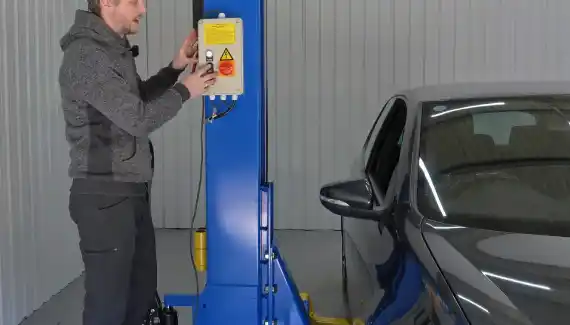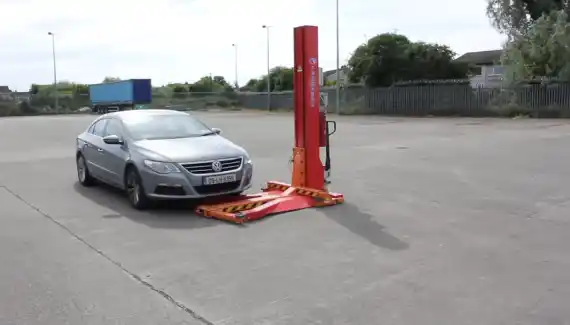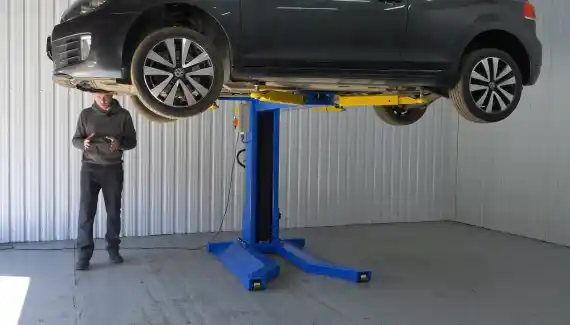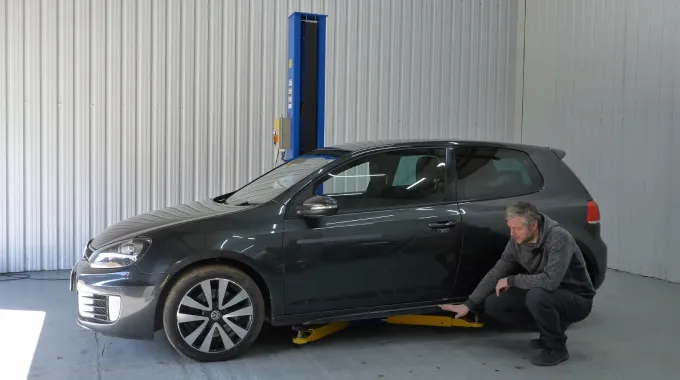Last Updated on April 11, 2023
The safety of a single-post car lift depends on how you use and maintain it. If you use it properly and with caution, single-post car lifts can be a safe and efficient way to lift and work on vehicles.
Don’t let potential safety concerns take the fun out of using a single-post car lift. It’s crucially important to observe all manufacturer guidelines and recommendations when it comes to keeping yourself, your property, and those around you safe.
Let us explore how you can make sure that any experience with these lifts is an enjoyable one, free from accidents or injuries.
Are Single Post Car Lifts Safe: 3 Explanations

Single-post car lifts can make any home garage or workshop feel like a pro shop, but it’s important to understand the potential safety risks.
Learn what factors affect stability, weight capacity, and overall wear on these popular tools – so you stay safe while tinkering under the hood.
1. Stability
A single-post car lift is not as stable as 2-post lift or 4-post lift, and this can present some potential safety concerns.
The single-post design means that while one-post lifts offer great access to the underside of a vehicle, they are less stable than a two-post or four-post lift due to having only one point of contact with the ground.
This lack of stability makes them more vulnerable to shifting or tipping during operations. If the surface on which it is installed is uneven or soft, the lift can become even less stable. When a lift is unstable, both the vehicle and the mechanic are at risk.
2. Weight Bearing Capacity
The lifting capacity of single-post car lifts is an important factor to consider when evaluating their potential safety concerns.
Most single-post automotive lifts are rated around 6000 pounds to 10000 pounds. Still, heavier vehicles will require higher capacity models that may cost more money but offer additional benefits in terms of stability and sturdiness.
Consult an expert if you’re unsure whether your vehicle’s weight exceeds the recommended limit for your automotive lift model.
In addition to choosing an appropriate model based on weight ratings, it is also important to ensure that you do not overload any type of car lift beyond its rating. This could result in severe injury or even death if something were to go wrong while in use.
When working with heavier vehicles, ensure all safety measures are taken according to the manufacturer’s specifications and never exceed the load limit indicated for your chosen vehicle lift type.
3. Wear and Tear
Another potential safety concern with using single-post car lifts is wear and tear over time. As time goes on, components such as nuts and bolts or cables may become loose due to vibration or usage, which could cause instability when lifting or lowering cars onto them.
If this isn’t addressed promptly, it could lead to serious accidents. Make sure everything stays secure at all times during use by checking for loose components regularly.
Also, rusting can weaken metal parts, causing them to become unstable under increased pressure from heavy vehicles being lifted onto them.
Regularly inspecting your single-post car lift for any signs of damage will significantly reduce the chances of an accident occurring due to wear and tear over time.
How to Ensure the Safety of Single Post Car Lifts?

Despite potential safety concerns, single-post car lifts remain a safe and reliable way of lifting or lowering vehicles.
You can feel comfortable working with these types of car lifts by following the manufacturer’s guidelines, ensuring that your lift is regularly inspected for malfunctions, and never exceeding its weight capacity. Below are some additional tips to ensure the safety of your single-post car lift:
1. Choose a Right Weight-Rated Lift
Regarding single-post car lifts, safety should be the top priority. That’s why it is important to choose a lift that is rated for the weight of the vehicle. If you choose a lift that is too weak for your vehicle, it can cause the lift to break or malfunction and put you in danger.
To ensure your safety, make sure that you purchase a lift that has been tested and certified. Also, check the maximum weight capacity of the lift before purchasing and make sure it can handle your vehicle’s weight.
2. Place the Lift on the Level Surface
To ensure maximum safety when using single-post car lifts, it is important to place them on a level surface. Uneven surfaces can cause instability and increase the risk of injury while using the lift.
Before operating your lift, take measurements with a level tool to make sure that all four corners are sitting on a flat surface. If necessary, use shims or other leveling devices underneath each corner until they are all perfectly leveled out.
3. Proper Installation
When installing your single-post car lift, following manufacturer instructions carefully is key for ensuring safety. Most manufacturers will provide comprehensive installation guides along with their products which must be followed precisely to avoid any accidents or malfunctions during operation.
Also, always use secure anchor points when attaching your lift to the floor or other stable surfaces. This will prevent any unexpected movements during lifting operations that could result in serious injury.
4. Properly Position and Secure The Vehicle

Correctly positioning and securing vehicles before operating single-post car lifts is also essential for optimal safety.
Make sure that you carefully read through all manufacturer instructions before beginning operations and position your vehicle according to those guidelines. This will reduce any chance of accidents happening during lifting processes.
Always use wheel chocks when available, as they help keep vehicles in place. At the same time, they are being lifted up into the air.
This reduces any risk of sudden slipping from occurring due to unexpected movement from within vehicle components such as brakes or gears etc. Every step of the way, make sure everyone stays safe.
5. Proper Use
To ensure the safe use of a single-post lift, always follow the lift’s safety guidelines when operating it. This includes following all instructions on how to raise and lower, as well as how to adjust any settings like pressure or speed.
Inspect your machine before beginning work on it. This will help you detect any potential issues that may occur during lifting or lowering.
Keep an eye out for any signs of wear or tear on the parts of your vehicle while working on it. If you spot anything suspicious, contact a professional immediately for advice.
6. Personal Safety
Your personal safety should always be a top priority when using a single-post lift. Always wear protective gear such as safety glasses, gloves, and sturdy shoes when handling any heavy equipment or tools associated with lifting a vehicle with a car lift.
Be mindful of your body positioning when working around any moving parts. Make sure you don’t stand too close in areas where there is a risk of getting hit by falling objects or exposed edges from equipment used for lifting vehicles.
Above all else, if you ever feel uncomfortable working with a portable single post lift, stop immediately and seek professional guidance before continuing work.
How Often Should You Perform Maintenance Checks on Your Single-Post Car Lift?

Your single-post car lift should be checked and maintained regularly to keep it safe and working. Generally, a full service and lift inspection should be performed annually.
If you are using the lift frequently or if it is in an environment that could cause wear and tear more quickly, it may be necessary to conduct inspections more regularly.
During these inspections, it is important to check for any signs of wear and tear and ensure that all nuts and bolts are tightened correctly. Look for any leaks in the hydraulic system, lubricate all moving parts, and ensure all locks and restraints are working correctly.
How Do You Know If Your Single Post Car Lift Needs to Be Repaired or Replaced?
If you notice any signs of wear or damage on your single post lift, such as leaking hydraulic fluid or malfunctioning locks or restraints, then it is likely time for repairs or replacement.
Other indicators that may signal the need for repair include an inability to reach certain heights with the arm of the lift or difficulty lifting heavier vehicles.
If any of these issues occur during regular use, then it is best to have a certified technician inspect the equipment before continuing usage to prevent any further damage or risk of injury.
How Much Space Do I Need to Install a Single Post Car Lift In My Garage?
The amount of garage space required to install a single-post car lift depends on the size (overall height, lifting height) and capacity of the lift, as well as the size of the vehicle you plan to lift.
As a general rule of thumb, you will need a garage with a minimum ceiling height of around 11-12 feet to accommodate a standard single-post car lift and a raised vehicle.
The actual floor space required for the lift itself can vary depending on the specific model and capacity. Still, it’s generally recommended to have a floor space of around 8 feet by 8 feet or more to accommodate the lift and the vehicle.
Safely Raise Your Vehicle with a Single-Post Car Lift

To sum it up, single-post car lifts are safe if all safety guidelines provided by the manufacturer are followed properly.
It is important to inspect the lift for any sign of damage or wear before use, as well as ensure that all connections are secure and that the weight capacity is not exceeded.
Also, remember that any repair work on a raised vehicle should be done from a safe height and always have someone spotting from below. With these safety protocols in place, you can use single-post car lifts without worry and get your work done safely and efficiently.
